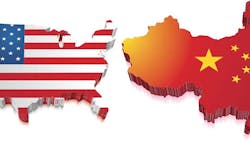Leaving China: How High Production Costs and Patent Infringement Turned the Tide
In 2009, Peerless Industries, a manufacturer of A/V solutions, took a hard look at the costs of its operations in China which produced a third of its products. "Our inability to switch designs quickly due to lead time restrictions from China combined with our litigation issues were placing us at a disadvantage," explained Mike Campagna, president/COO of Peerless-AV.
Switching designs, which is necessary in this competitive market, would take six months. This was due to the requirement of having so much inventory in the pipeline. "You would need at least one to three months of inventory in the U.S., another month at the consolidator and another month at the consolidators supplier. It was getting too costly and taking us to long to adapt to the market," explained Campagna.
Patent infringement was also a huge burden for the company. Though the company is still trying to resolve this issue, Campagna has some advice for other manufacturers about patent protection. "The smart thing to do is to patent your products in China, as opposed to the U.S. Once you find a Chinese company that is infringing on your patent its fairly easy to shut them down with a threat or showing them the patents. The Chinese government has also been coming down hard on this issue. They are protecting Chinese- patented products," said Campanga.
The reason Peerless opened a plant in China back in early 2000 was the lack of the type of manufacturing capacity to produce aluminum-based products. Peerless couldnt find a supplier that was cost-effective and so took that part of the business overseas. But in 2009 various costs of doing business in China outweighed the benefit, especially when combined with the litigation costs (which continue today) of trying to protect its patents.
Timing has something to do with it as well since in 2009 there was die-casting equipment on the market due to tough economic times. And there were unemployed workers who had this type of experience. So the company found a location in suburban Chicago and aided with government incentives brought this expertise in-house and opened a plant in March of 2012.
With this new plant in the U.S. the company hoped it would garner positive attention. Marketing the company's product as Made in America, hasn't quite had the impact that they hoped it would. "While 95% of the products for the American market are made here, most of our customers are still focusing on costs rather than production location. However some of our commercial and professional customers do like the fact that our products are made in the U.S." says Campagna.
The new 307,813-square-foot headquarters building has allowed the company to consolidate both the China plant and its Illinois-based plant in one location. The headquarters has LEED green building certification and other environmentally upgrades. The company has already installed a system where the heat generated by its die casting furnaces is recycled and channeled throughout the factory providing the heat during the winter months. The machinery in the plant is equipped with electric usage monitoring devices that inform the companys as to the energy usage of each machine. This in turn provides the ability, when possible, to run energy hungry equipment in off-peak hours to save energy and costs. Finally, dirty water from the manufacturing process is filtered, cleaned and then evaporated. Any remaining sludge is then properly disposed of.
"As a whole, the combination of these actions have reduced our carbon footprint and have reduced the energy costs at our manufacturing facility," said Campagna.
Future plans include solar panels and wind turbines will be installed to generate sustainable low-cost power for the building.
